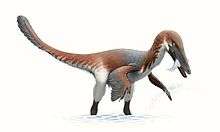Adasaurus
| Adasaurus Temporal range: Late Cretaceous, 70 Ma | |
|---|---|
 | |
| Drawing of the pelvis | |
| Scientific classification | |
| Kingdom: | Animalia |
| Phylum: | Chordata |
| Class: | Reptilia |
| Clade: | Dinosauria |
| Order: | Saurischia |
| Suborder: | Theropoda |
| Family: | †Dromaeosauridae |
| Clade: | †Eudromaeosauria |
| Subfamily: | †Dromaeosaurinae |
| Genus: | †Adasaurus Barsbold, 1983 |
| Type species | |
| Adasuarus mongoliensis Barsbold, 1983 | |
Adasaurus (/ˌɑːdəˈsɔːrəs/ AH-də-SAWR-əs; "Ada's lizard") is a dromaeosaurid theropod dinosaur from the Late Cretaceous Period of Central Asia. It was a small bipedal carnivore with a sickle-shaped claw on the second toe of each hind foot, and was perhaps 1.8 m (5.9 ft) long.[1] The genus name Adasaurus is taken from Ada, an evil spirit in the mythology of Mongolia, and the Greek word sauros meaning 'lizard'. The species name, for the single species, (A. mongoliensis), refers to the country of origin. Adasaurus was named and described in 1983 by Mongolian paleontologist Rinchen Barsbold.[2]

Adasaurus is a member of Dromaeosauridae, a group that is closely related to living birds. Other dromaeosaurids include Deinonychus, Velociraptor, Microraptor, and Buitreraptor. The relationships of Adasaurus are poorly understood. Traditionally, Adasaurus is assigned to the Dromaeosaurinae, which includes heavily built animals such as Dromaeosaurus and Utahraptor [3][4] but several recent studies have suggested that it may be a member of the Velociraptorinae instead.[5][6]
Two specimens of Adasaurus have been found, both from the Nemegt Formation in the Gobi Desert of southern Mongolia. The holotype, IGM 100/20, is an incomplete skeleton with partial skull, including the vertebral column except the back of the tail, all three bones of the pelvis, the shoulder girdle and the hindlimbs. The second specimen, the paratype IGM 100/51 also described in the original paper, consists of the back end of another skeleton, including the hindlimbs. Both specimens are currently in the collection of the Mongolian Geological Institute in Ulaanbaatar, Mongolia.
The age of the Nemegt is not known for certain, but it is commonly thought to belong to the Maastrichtian stage of the Late Cretaceous Period.,[7] and Adasaurus would therefore have lived between 72 and 66 million years ago. Other dinosaurs found in this formation include the tyrannosaur Tarbosaurus, the ornithomimid Anserimimus, the troodontid Zanabazar, and the hadrosaur Saurolophus.
See also
References
- ↑ Holtz, Thomas R. Jr. (2008) Dinosaurs: The Most Complete, Up-to-Date Encyclopedia for Dinosaur Lovers of All Ages Supplementary Information
- ↑ Barsbold, Rinchen (1983). "Carnivorous dinosaurs from the Cretaceous of Mongolia". Transactions of the Joint Soviet-Mongolian Paleontological Expedition (in Russian). 19: 5–119.
- ↑ Norell, Mark A.; Peter J. Makovicky (2004). "Dromaeosauridae". In David B. Weishampel, Peter Dodson and Halszka Osmólska. The Dinosauria (2nd ed.). Berkeley, California: University of California Press. pp. 196–209. ISBN 0-520-24209-2. OCLC 55000644. Retrieved 24 May 2009.
- ↑ Makovicky, Peter J.; Sebastián Apesteguía; Federico L. Agnolín (2005). "The earliest dromaeosaurid theropod from South America". Nature. 437 (7061): 1007–1011. Bibcode:2005Natur.437.1007M. doi:10.1038/nature03996. PMID 16222297.
- ↑ Senter, Phil, et al. "New dromaeosaurids (Dinosauria: Theropoda) from the Lower Cretaceous of Utah, and the evolution of the dromaeosaurid tail." PloS one 7.5 (2012): e36790.
- ↑ Longrich, Nicholas R., and Philip J. Currie. "A microraptorine (Dinosauria–Dromaeosauridae) from the Late Cretaceous of North America." Proceedings of the National Academy of Sciences 106.13 (2009): 5002-5007.
- ↑ Jerzykiewicz, T.; D.A. Russell (August 1991). "Late Mesozoic stratigraphy and vertebrates of the Gobi Basin". Cretaceous Research. 12 (4): 345–446. doi:10.1016/0195-6671(91)90015-5.

